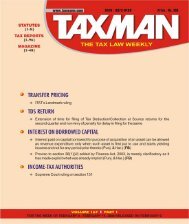CPT V24P7-Art1 (Content).pmd - Taxmann
CPT V24P7-Art1 (Content).pmd - Taxmann
CPT V24P7-Art1 (Content).pmd - Taxmann
You also want an ePaper? Increase the reach of your titles
YUMPU automatically turns print PDFs into web optimized ePapers that Google loves.
Direct Tax Laws<br />
680<br />
(e) The aggregate amount included under<br />
Lease Adjustment Account on account<br />
of lease equalization credits should<br />
be disclosed separately.<br />
The method of income measurement<br />
suggested in this paragraph, is in<br />
consonance with the inherent nature of<br />
a finance lease.”<br />
Thus, the “guidance notes” effective till AS 19<br />
was issued, made it obligatory on the part of<br />
the companies to debit to the lease rentals,<br />
annual lease charge comprising of minimum<br />
statutory depreciation and lease equalization<br />
charge, where the annual lease charge is more<br />
than the minimum statutory depreciation.<br />
On 1-4-2001 Accounting Standard AS 19 about<br />
accounting of leases was for the first time<br />
published by the ICAI and was made effective<br />
in respect of leases commencing on or after<br />
that date. AS 19 provides accounting of “Leases”,<br />
appropriate accounting policies and disclosure<br />
in relation to finance leases and operating leases.<br />
Para 26 thereof provides that lessor should<br />
recognize asset given under finance lease in<br />
its balance sheet as receivable at an amount<br />
equal to the net investment in the lease. As<br />
per para 27 thereof the lease payment receivable<br />
is treated by the lessor as repayment of principal,<br />
i.e., net investment in the lease and finance<br />
income to reimburse and reward the lessor for<br />
its investment and services. As per para 28<br />
finance income is recognized on the basis of<br />
a constant periodic rate of return on the net<br />
investment of the lessor outstanding in respect<br />
of the lease.<br />
Hon'ble High Court noticed that there is no<br />
conflict between AS 19 and any provision of<br />
the IT Act. Further, the Government has not<br />
notified any Accounting Standards in respect<br />
of lease, even though it has notified other<br />
Accounting Standards as required under section<br />
145(2). Therefore, the Hon'ble High Court in<br />
the impugned judgment took the view that<br />
recognition of revenue out of lease rentals will<br />
be governed by AS 19 by apportionment of<br />
August 1 to 15, 2012 u TAXMANN’S CORPORATE PROFESSIONALS TODAY u Vol. 24 u 60<br />
lease rentals into capital recovery and finance<br />
charges. There is a rationale in such an<br />
apportionment. Depreciation claimed according<br />
to the IT Act or according to the Companies<br />
Act may not always be equal to actual reduction<br />
in value of the asset with passage of time and<br />
due to wear and tear. The market value (residuary<br />
value) of the leased asset at the end of the<br />
lease period may not be equal to the written<br />
down value (WDV). The difference between<br />
the residuary value (Say RV) of the leased<br />
asset and its written down value is adjusted<br />
yearly by an amount called the “lease equalization<br />
charges”. It can be positive, meaning thereby<br />
that RV is more than WDV. It will result into<br />
a profit chargeable to tax. From the same logic<br />
if RV is less than the WDV, then the lease<br />
equalization charge will be negative and will<br />
be a charge on the profit. Thus, “lease<br />
equalization charges” are yearly adjustment<br />
entries to act as supplement to, or recovery<br />
from, statutory depreciation claimed and debited<br />
to P/L account and signify full recovery of<br />
value of asset reduced during the lease period.<br />
This can be claimed in the profit and loss<br />
account.<br />
The concept of apportionment of receipt into<br />
capital and revenue can also be understood<br />
from EMIs received by a finance company on<br />
grant of a housing loan or a car loan. EMIs<br />
consist of return of principal and interest and<br />
entire loan along with interest is paid back at<br />
the end of the term of the loan. What is taxed<br />
in the hands of the lender is not the entire EMI<br />
received by the lender but only the interest<br />
part of it. The other part is the recovery of<br />
capital advanced as a loan.<br />
Theoretically the concept of real income is<br />
applicable when there is technical or legal<br />
right to receive an income but really no income<br />
is received due to factors beyond the control<br />
of the assessee. In State Bank of Travancore v.<br />
CIT [1986] 24 Taxman 337 (SC) question of<br />
interest on sticky loans accrued to the assessee<br />
was involved: In Godhra Electricity Co. Ltd. v.<br />
CIT [1997] 91 Taxman 351 (SC) issue regarding











![“FORM NO. 3CEB [See rule 10E] Report from an ... - Taxmann](https://img.yumpu.com/45480232/1/190x245/form-no-3ceb-see-rule-10e-report-from-an-taxmann.jpg?quality=85)





